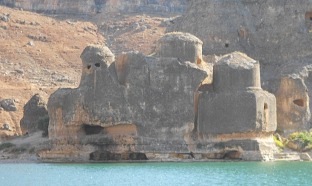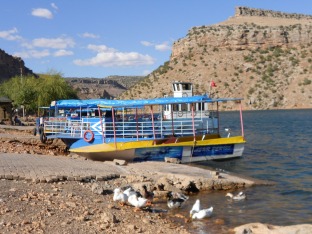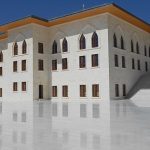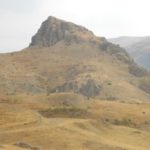I bump into Ali inside the ruins of the castle at Eğil. He’s collecting medicinal herbs in an old water bottle but is keen to stop and chat to a stranger.
“Come round here,” he instructs me. “The view is much better.”
Eğil Castle stands high above a gorge on the Tigris which was flooded to form a lake back in 1997 when the Amini Dam was built. “Before it was so green,” Ali says wistfully. “There were fields and fields of apples, pears and pomegranates. The trucks came in their hundreds to take them away.”
We stand side by side looking at the new view. It’s still lovely of course but in the rather harsh, rather sterile way of artificially created lakes that lack a fringe of greenery to soften their edges. Ali points out where the old river used to flow. “There was a hamam beside the water,” he says. “And houses.” Now the buildings stand in ruins and the riverbed is virtually dry.
Ali had retired from a job at the post office so I took him to be a similar age to me. “Do you remember when the dam was completed?” I ask him, imagining what a traumatic day that must have been.
“Of course,” he says quietly. “The water rose slowly at first, then more and more came.”
He leads me back to the path that runs out of the castle, pausing to show me several deep cisterns cut into the rock and a rock-cut manger very similar to the ones I have in my own Cappadocian home.
Far below the castle there’s a jetty for a ferry that plies back and forth across the lake so that villagers living on the far side can get to Eğil and then to Diyarbakır. A few pleasure boats are also tied up by the shore and I pay for one to take me out for a quick look at the strange rock-cut tombs of the rulers of Sophene, an Armenian kingdom of the second and first centuries BC. Three of them stand in a row just above the surface of the water. The furthest away is the most extraordinary; it looks remarkably like a statue of a woman wearing a burqa.
Mahmud, the boatman, is a cheery soul, happy to point out all the sights to me. The boats have been here for the last seven years, he tells me, and in summer I imagine they must provide him with a decent income. At this time of year though it’s hard to see how he would earn enough to cover the cost of the engine fuel.
Back on shore I amble past the ramshackle restaurant where, looking down from the castle, I had fondly imagined myself taking a late lunch. Sadly I find it closed, for the season, I assume, until I see a dejected-looking individual sitting at a table at the far end fiddling with his phone. “Does it open at weekends?” I ask him.
“No, it’s closed for a court case,” he tells me gloomily.
“No permission?” I ask in what I hope is a matey, we’re-all-in-this-together sort of tone.
“No, I had all the permissions but they’re still taking me to court…”
“Sorry to hear that. Good luck then,” I say and walk away. Nearby stands a much newer-looking restaurant right beside the water. It has that neat and tidy look that the authorities are so fond of. It’s even called “Sosyal Tesisleri (Social Facilities)” which usually means an authority-run operation. I have a nasty feeling in my stomach. It looks as if this is the approved operation while the other one is not. Perhaps surprisingly then this, too, was closed, so perhaps I’m being unduly suspicious.
Walking back to the top of the hill I pass a group of women sitting together on the flat roof of a house overlooking the old river valley. “Gel, gel,” they yell, so I mount the short wooden ladder to join them.
It turns out that they are making pestil, a strange sort of chewy sweet much loved by people in eastern Turkey. I’ve never given much thought to how pestil is made but now they show me how the mixture is made from grapes, then spread over cloths and left to dry. Once it has solidified the cloth is turned over and soaked again from the back making it easy to peel the dried pestil off it. Then the sheets are hung up to dry rather like the laundry.
 The women are speakers of Zazaki, a Kurdish dialect, and find it entertaining to fire phrases at me and watch my consternation at not being able to understand them. But they are kind women, and warm with it. Despite my protests I struggle back down the ladder again with my backpack full of pestil.
The women are speakers of Zazaki, a Kurdish dialect, and find it entertaining to fire phrases at me and watch my consternation at not being able to understand them. But they are kind women, and warm with it. Despite my protests I struggle back down the ladder again with my backpack full of pestil.
Eğil itself is distinctly bereft of attractions aside from the curiosity of seeing a giant new mosque under construction immediately across a small park from another equally large one, a battle of the worshippers apparently underway.
As I amble back to the bus stop a man summons me to join him for çay. As we sit together I find myself half-wishing that I didn’t understand any Turkish as he pours out a relentless tale of woe. It starts with the Armenians. Thrown into the wells in the castle, he says with a grim look on his face. Then there was the coup. “Terrible things, terrible things,” he says. His own father had been sent into exile near Erzurum, an experience so awful that it had scarred him for life. Then came the fighting of the 1990s. “Young men of seventeen. They hanged them in Diyarbakır,” he said, making suitable hand gestures just in case I haven’t understood him.
Needless to say, he doesn’t have much time for the sort of tinkering at the edges that recently “permitted” the Kurds to use the Q, W and X that are an intrinsic part of their alphabet. Luckily my bus back to Diyarbakır arrives just as he is about to start expounding on that subject. Despite the beauty of its setting and the curiosity of its ancient history I find myself leaving Eğil with a heavy heart.
Written: 12 March 2015, edited 2024


